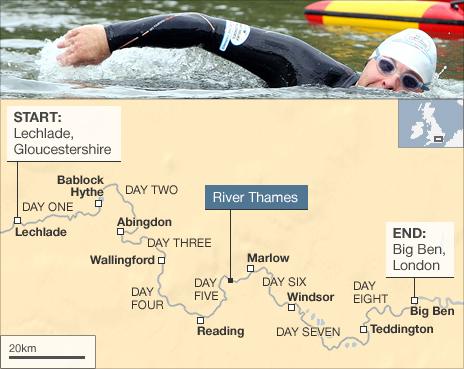Who, What, Why: How hard was David Walliams' Thames swim?
- Published
Walliams sets off on Big Splash Thames Challenge for Sport Relief
Comedian David Walliams has finished a 140-mile swim (225km) of the River Thames for charity. How tough a challenge is this?
Swimming the Thames from Lechdale, Gloucestershire to Westminster Bridge is a task few would want to take on, and David Walliams raised nearly £1m for charity as he neared the finish line.
But just how difficult a feat was it for the Little Britain star - who, though not up to the standards of a professional athlete, is a strong swimmer who has previously successfully tackled the English Channel?
Former Commonwealth swimming gold medallist Sharron Davies says the distance Walliams tackled was not in itself remarkable, given that an Olympic contender in training might expect to swim some 7,000 metres (23,000 ft) twice a day.
But she adds: "What makes it so hard is doing it in dirty water with low visibility and tides while swans are attacking you - it's a very impressive achievement."
Certainly, Walliams' training regime in rivers for his Sport Relief Big Splash Challenge, external exposed him to the kind of obstacles that are rarely encountered in swimming pools.
"I was hit by rowing boat oars, attacked by swans and got covered in insect bites from all the bugs that live in the weeds. It was also very, very cold," he said before embarking on the charity swim.
Additionally, his progress was marred by the river's more feculent contents. According to Thames Water, some 500,000 cubic metres (17,660,000 cubic feet) of raw sewage entered the London section of the Thames in the week before Walliams reached it.
Unsurprisingly, the comedian suffered a bout of "Thames tummy" despite receiving several inoculations since he set off on on 5 September.

The final section of the course proved to be tough in the extreme, with increased boat traffic as well as strong currents and undertows as the river becomes tidal.
With Walliams burning an estimated 4,400 calories every day, the sheer physical demands were considerable - although Walliams, who crossed the 22-mile (35 km) English Channel in a respectable 10 hours and 34 minutes, was physically well-equipped for this task.
However, according to Davies, it is the mental toughness required to keep going that is more difficult to achieve.
"It's the ability to just zone out and keep going that I find most impressive," she adds.
One swimmer who has experienced the hazards of the tidal Thames is Times columnist Matthew Parris, who in 2010 crossed the river from Rotherhithe to Limehouse by breast stroke wearing a singlet and a pair of swimming trunks.
Though he is keen to point out that his hour-long expedition - for which he was criticised by the Port of London Authority - was nowhere near as onerous as that faced by Walliams, he says even such a short swim is much more difficult than an onlooker might imagine.
"When you stand above the river you think, 'That's easy, I could get across,'" Parris recalls. "But when you're in the water it's a very different matter.
"It was much choppier than I expected it to be. He'll be finding that other shipping is a problem by now, as well."
Sewage, tides, river traffic and swans have not been the only obstacles Walliams has confronted. He also rescued a labrador named Vinny who jumped into the water alongside him.